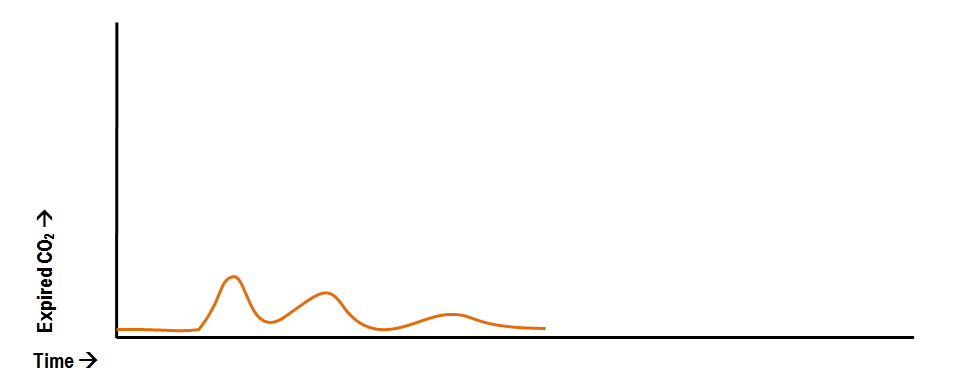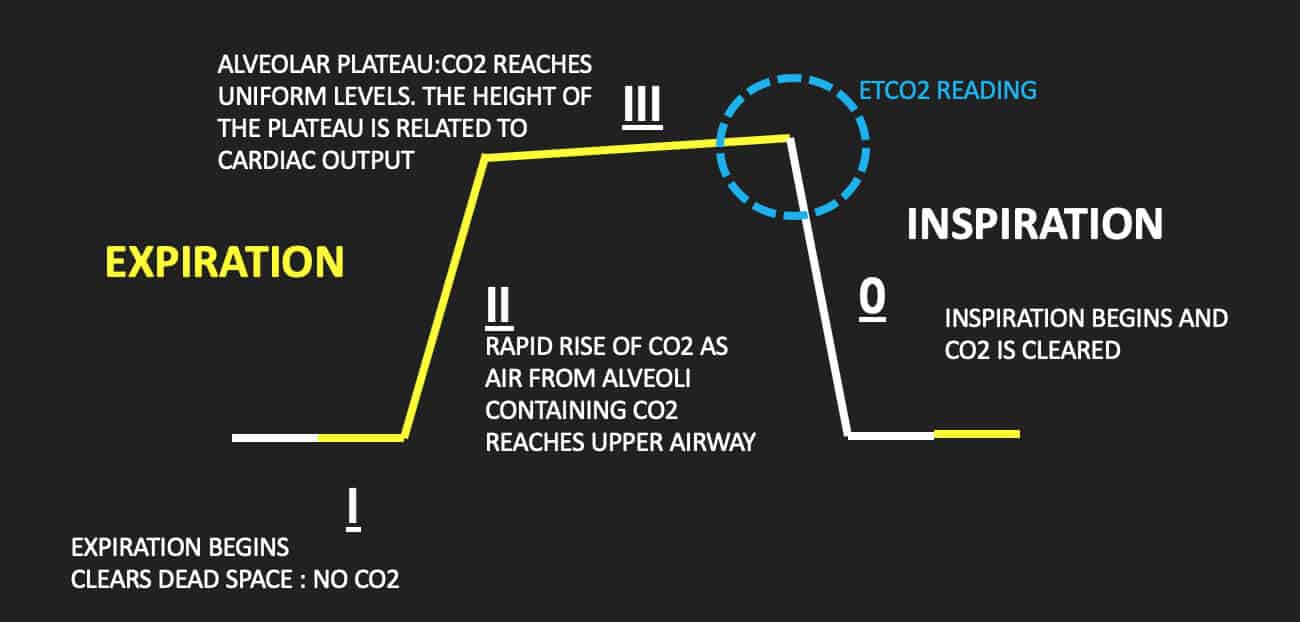low end tidal co2 after intubation
CO2 EtCO2 the maximum CO2 concentration at the end of each tidal breath can be used to assess disease severity and response to treatment. End-tidal carbon dioxide Et co 2 is a valuable marker of the return of adequate circulation after cardiac arrest due to medical causesPreviously the prognostic value of capnography in trauma has been studied among limited populations in prehospital and emergency department settings.

Evidence Supports Using End Tidal Carbon Dioxide To Detect Prehospital Sepsis Jems Ems Emergency Medical Services Training Paramedic Emt News
End tidal normally 2-5 mmHg lower than arterial Comparing Arterial and End-tidal CO2 Review of Airway Confirmation Visualization Auscultation.

. Dead-space ventilation results in ventilated alveoli with insufficient perfusion which leads to low ETco 2. Monitoring of end-tidal carbon dioxide EtCO2 is a noninvasive method that measures the partial pressure or maximal concentration of carbon dioxide CO2 at the end of exhaled breath which is expressed as a percentage of CO2. Capnography monitoring as a clinician tool to help enhance patient care is used in multiple environments from the emergency room ER to the ICU.
Attach End-Tidal CO2 detector to the Blind Insertion Airway Device or the Endotracheal Tube. The gradient between the blood CO 2 PaCO 2 and exhaled CO 2 end-tidal CO 2 or PetCO 2 is usually 5-6 mm Hg. The patients physical examination vital.
Measurement of a low ETCO 2 value 10 mmHg during CPR in an intubated patient suggests that the quality of chest compressions needs improvement. The normal values of end-tidal CO 2 is around 5 or 35-37 mm Hg. Like pulse oximetry before it alerting us to changes in oxygenation end-tidal CO2 monitoring or ETCO2 is rapidly becoming an additional vital sign.
The use of quantitative end-tidal capnometry to avoid inadvertent severe hyperventilation in patients with head injury after paramedic rapid sequence intubation. This disposable bedside detector registers three ranges of CO2 concentration. A purple indicates low levels and probable esophageal intubation.
The effectiveness of out-of-hospital use of continuous end-tidal carbon dioxide monitoring on the rate of unrecognized misplaced intubation within a regional emergency medical services system. Silvestri S Ralls GA Krauss B et al. A semiquantitative colorimetric FEF end-tidal CO2 detector Fenem Inc New York NY was used to evaluate endotracheal versus esophageal intubation.
But ETCO2 can also provide valuable information on the adequacy of cardiac perfusion. The effectiveness of out-of-hospital use of continuous end-tidal carbon dioxide monitoring on the rate of unrecognized misplaced intubation within a regional emergency medical services system. The End-Tidal CO2 detector shall be used with any Endotracheal Tube or Blind Insertion Airway Device use.
Murphy RA Bobrow BJ Spaite DW et al. Association between prehospital cpr quality and end-tidal carbon dioxide levels in out-of-hospital cardiac arrest. Misting increased SaO2 Types of End-Tidal CO2 Qualitative Yes or No.
Ensure proper rate approximately 100min Ensure proper depth with adequate releaserecoil of thorax 12 thorax or minimum 25 inches Persistently low EtCO. To maximize the benefits of capnography a solid knowledge of all aspects of capnography measurements is required. End-tidal carbon dioxide and defibrillation success in out-of-hospital cardiac arrest.
Congratulations youre in the oesophagus. Capnography is also the most reliable indicator that an endotracheal tube is placed in the trachea after. Though initially there is some CO 2 returning though the tube one finds with subsequent breaths the end tidal graph is lower and lower and the patient is getting more and more hypoxic.
Annals of Emergency Medicine. End-tidal carbon dioxide cannot be used to rule out severe injury in patients meeting the criteria for trauma care. In normal conditions CO2 is 5 to 6 which is equivalent to 35-45 mmHg.
Measuring end-tidal CO2 in cardiac arrest patients is helpful for confirming tracheal tube placement assessing the effectiveness of chest compressions predicting likelihood of return of. This may result from such ventilatory problems as high mean airway pressure or inadequate exhalation time resulting in overdistention or from such circulatory problems as. Confirmation of endotracheal intubation is vital in airway management in the emergency department.
A low end-tidal CO2 in hypothermia. Alveolar dead space may be increased in most types of lung disease reflecting dysfunction at the alveolar vascular or airway level. A high peak of the alveolar phase in poorly compliant lungs.
End-tidal clearance must be evaluated in the context of the patients perfusion status. The use of quantitative end-tidal capnometry to avoid inadvertent severe hyperventilation in patients with head injury after paramedic rapid sequence intubation. Negative Epigastric sounds Equal lung sounds Esophageal detector End tidal CO2 detector Secondary signs.
B beige indicates moderate levels and probable tracheal intubation. Silvestri S Ralls GA Krauss B Thundiyil J Rothrock SG Senn A et al. We present a case in which the Dräger Primus Dräger Medical AGCo KG Lüberck Germany anesthesia monitor displayed false readings of low end-tidal carbon dioxide EtCO2 immediately after intubation.
An end-tidal carbon dioxide level of 10 mmHg or less measured 20 minutes after the initiation of advanced cardiac life support accurately predicts death in patients with cardiac arrest associated with electrical activity but no pulse. End-tidal carbon dioxide reflects CO 2 concentration of alveoli emptying last. EtCO2 is a measurement of the partial pressure of CO2 in gas expired at the end of exhalation when exhaled gas will most closely resemble the alveolar CO2 concentration.
A low P a CO2 level is correlated with increased risk of cerebral edema in children with DKA. Savastano S et al. We routinely use ETCO2 to provide information on ventilation.
Consequently a strategy of high-frequency low-tidal volume breaths will tend to achieve less CO2 clearance for any specific total minute ventilation. The Difference Between Arterial and End Tidal CO2. Can the value of end tidal CO2 prognosticate ROSC in patients coding into emergency department with an out-of-hospital cardiac arrest.
For example increased dead space is seen in pulmonary embolism in pneumonia or. It is strongly recommended that continuous Capnography be used in place of or in addition to the use of an End-Tidal CO2 detector.

Etco2 Valuable Vital Sign To Assess Perfusion The Airway Jedi
End Tidal Co2 The Drummer Of The Vital Sign Band Pem4

Waveform Capnography In The Intubated Patient Emcrit Project

Abnormal Capnography Waveforms And Their Interpretation Deranged Physiology

3 Waveform Capnography Showing Changes In The End Tidal Carbon Dioxide Download Scientific Diagram

Waveform Capnography In The Intubated Patient Emcrit Project

Etco2 Valuable Vital Sign To Assess Perfusion The Airway Jedi

Waveform Capnography In The Intubated Patient Emcrit Project

The Impact Of Ventilation Rate On End Tidal Carbon Dioxide Level During Manual Cardiopulmonary Resuscitation Resuscitation
Emdocs Net Emergency Medicine Educationcapnography In The Ed Emdocs Net Emergency Medicine Education

Waveform Capnography In The Intubated Patient Emcrit Project

Waveform Capnography In The Intubated Patient Emcrit Project

Quantitative Waveform Capnography Acls Medical Training

A Systematic Approach To Capnography Waveforms Jems Ems Emergency Medical Services Training Paramedic Emt News

Waveform Capnography In The Intubated Patient Emcrit Project



